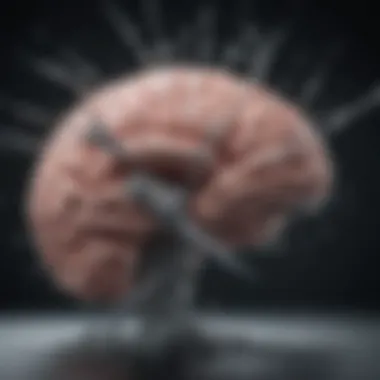Lithium as an Antipsychotic: Insights and Implications


Intro
Lithium, a simple metal with the atomic number 3, has carved out a significant niche in the realm of mental health treatment. Though initially discovered in the 19th century, its use in psychiatry began gaining traction in the 1940s. Since then, lithium has become a cornerstone for treating various mood disorders, particularly bipolar disorder.
The complexity of lithium's function in the brain has sparked extensive research, leading to myriad insights into how it stabilizes mood and mitigates the peaks and valleys of emotional states. But, it’s not all rosy—like every medication, lithium comes with its share of complications and nuances that healthcare providers must navigate carefully.
From its unique pharmacological properties to its long-standing efficacy, this article seeks to unpack the many layers of lithium's role in modern psychiatry. By examining its clinical applications, potential risks, and the latest findings in research, we aim to provide a broad but in-depth perspective for medical professionals and interested individuals alike.
Preamble to Lithium Antipsychotics
Lithium has carved its niche as a cornerstone in the pharmacological landscape for treating mood disorders. By exploring lithium antipsychotics, we can unravel intricate connections between this substance and its multifaceted applications in clinical settings. It's essential to appreciate lithium not only for its therapeutic effects but also for its historical evolution, development through various stages, and its enduring relevance in contemporary mental health discourse.
Historical Background
The journey of lithium in psychiatry is rich and layered. In the mid-20th century, lithium was first recognized for its mood-stabilizing properties, primarily used to treat bipolar disorder. Before that, the drug's lineage can be traced back to the 19th century when it was acknowledged for its physiological effects on animal behavioral patterns. Researchers like John Cade in Australia, who conducted groundbreaking studies in the late 1940s, were pivotal in uncovering lithium's potential for managing mania. His work laid the foundation for lithium's acceptance as a valid treatment option for psychiatric conditions.
In time, lithium transitioned from a somewhat obscure mineral into a widely prescribed medication. It became the gold standard and allowed many patients to regain a semblance of normalcy in their lives. The transition highlighted not just its efficacy but also underscored the importance of understanding how this versatile element fits into the broader spectrum of psychiatric care.
As decades rolled on, clinical studies and robust data further validated its effectiveness. Yet, even with this scientific backing, the early prescription paradigms often overlooked standardized dosing regimens or monitoring protocols, which were crucial in mitigating risks. Elementary gaps, such as possible toxicity, were discovered along the way, suggesting that understanding the full scope of lithium's profile was paramount for safe and effective treatment.
Current Relevance
Today, lithium holds an enduring position in the therapeutic arsenal for mental health professionals, particularly in the face of rising mood disorders. Various independent studies continue to explore its applications beyond bipolar disorder, considering its effectiveness in treating schizophrenia and refractory depression.
More recent research also touches upon unique aspects of lithium's pharmacological action. For example, emerging evidence suggests that it may possess neuroprotective properties, fostering resilience against specific neurodegenerative diseases. This notion introduces a novel conversation around lithium therapy that goes beyond mood stabilization, positioning it as a possible avenue for preventive treatment approaches in mental health.
In the stochastic reality of psychiatry, lithium’s role prompts deeper examination of integrative practices, personalized medicine, and ethical considerations in administering treatments. Understanding these layers helps not merely grasp lithium's importance as a medication but also contextualizes it within a broader ethical landscape where patient choice and informed consent should anchor any treatment plan.
As we continue to delve into the complexities surrounding lithium antipsychotics, it's vital to recognize their historical roots while keeping an eye on current practices and potential innovations. Only through this comprehensive lens can clinicians truly appreciate the implications of their prescribing decisions nowadays.
Pharmacological Profile of Lithium
Lithium, a naturally occurring element on the periodic table, stands out as an unconventional yet vital player in mental health treatment. Its pharmacological profile offers insights into its efficacy, applications, and challenges. Understanding the complexities of lithium’s chemical makeup, how it interacts within the body, and its metabolism is crucial for both clinicians and researchers delving into psychiatric care. This profile incorporates unique elements such as its ion exchange capabilities, making it a therapeutic favorite despite some trepidation surrounding its use.
Chemical Structure and Properties
Lithium is notably the lightest metal and presents a unique chemical structure characterized by a single positive charge. The simple atomic structure, comprising just three protons, three electrons, and four neutrons, allows lithium ions to easily traverse through cell membranes and interact with a variety of cellular mechanisms. This small size enables it to participate in ion exchange processes, critical in stabilizing mood.
The solubility of lithium salts, particularly lithium carbonate and lithium citrate, promotes their bioavailability, leading to effective therapeutic results when administered. Because of this solubility, lithium is usually employed in salt form for clinical use, allowing for manageable dosing and predictable absorption rates.
However, while lithium’s chemical properties establish its therapeutic potential, they also introduce certain considerations. For instance, its narrow therapeutic index warrants close monitoring to prevent toxicity. Clinicians must be vigilant in balancing efficacy with safety parameters.
Mechanism of Action
The mechanism by which lithium exerts its antipsychotic effects is multifactorial and quite intriguing. It primarily influences neurotransmitter dynamics, such as serotonin and dopamine, both pivotal in mood regulation. Lithium modifies signaling pathways including the inositol mono phosphate pathway, contributing to neuroprotection and mood stabilization.
A significant aspect of lithium’s action is its ability to modulate glutamate levels, a neurotransmitter unusually associated with mood disorders. Elevated glutamate is often observed in patients with bipolar disorder and schizophrenia. By dampening glutamate's activity, lithium helps restore balance, mitigating the manic and depressive episodes common in these conditions.
Moreover, its impact on neurogenesis — the creation of new neurons — provides a fascinating layer, hinting at lithium’s potential beyond mere symptomatic relief. The idea that lithium can foster the growth of brain cells opens doors for future exploration into long-term cognitive health.


"The therapeutic action of lithium ventures beyond symptomatic relief, suggesting a transformative potential in promoting neuron growth and mental well-being."
Pharmacokinetics
Understanding the pharmacokinetics of lithium illuminates how the drug behaves after administration. Upon ingestion, lithium salts dissolve quickly in the gastrointestinal tract, entering the bloodstream and distributing throughout body tissues. Its peak absorption usually occurs within two hours, although individual variations can occur based on dietary factors and concurrent medications.
Lithium is distinct in that it is not metabolized by the liver; rather, it is excreted unchanged primarily through the kidneys. Consequently, renal function plays a crucial role in determining lithium levels in the bloodstream. Clinicians must assess kidney health periodically, thus ensuring adequate excretion and preventing toxicity.
Furthermore, the half-life of lithium typically ranges from 18 to 36 hours depending on the patient’s renal function and hydration status. This relatively long half-life underscores the importance of consistency in dosing schedules to maintain optimal therapeutic levels and achieve the desired effects in patients.
Clinical Applications in Mental Health
Understanding the clinical applications of lithium antipsychotics is crucial in today's mental health landscape. With the increasing prevalence of mood disorders, the necessity for effective treatment options has become essential. Lithium is not just another medication; it is often considered a cornerstone in the management of various psychiatric conditions. This section will explore the significance of lithium’s applications in mental health, focusing on its usage in bipolar disorder, schizophrenia, and depression.
Bipolar Disorder
Bipolar disorder, characterized by alternating episodes of mania and depression, is one of the prime conditions where lithium is widely used. The mood-stabilizing properties of lithium can help in managing not only acute manic episodes but also depressive phases. Research supports the effectiveness of lithium in not only reducing the frequency and severity of mood swings but also in providing a level of protection against suicide in individuals diagnosed with this disorder. It serves as a crucial part of a comprehensive treatment plan, which might also include psychotherapy and other medications.
"Lithium has proven to be more than just a treatment; in many cases, it is a lifeline for those grappling with the emotional waves of bipolar disorder."
The benefits of lithium in treating bipolar disorder also extend to improved functioning in daily life. Unlike some other mood stabilizers that may have sedative effects, lithium often enables patients to maintain cognitive clarity and social engagement. This balance is essential for those seeking to lead normal lives despite their condition. However, it’s important to monitor lithium levels regularly, as maintaining the right dosage is critical to preventing potential toxicity.
Schizophrenia
Lithium’s role in treating schizophrenia is a bit nuanced. While it is primarily known for its effects on mood disorders, some clinicians are increasingly utilizing it as an adjunct treatment for individuals with schizophrenia, particularly in cases that also involve mood disturbances. The combination of lithium with traditional antipsychotics can enhance outcomes, especially in patients who experience mood fluctuations alongside their psychotic symptoms.
Evidence indicates that lithium may help mitigate some of the negative symptoms of schizophrenia, which can include emotional blunting and social withdrawal. The goal is not just stabilization of acute symptoms but also enhancement of social functionality and overall quality of life.
Depression
Depression, particularly when it is recurrent or resistant to standard treatments, can also benefit from lithium therapy. While traditionally not the first-line treatment for depressive disorders, lithium can be a powerful agent, especially in cases where patients don’t respond well to conventional antidepressants. It is sometimes used in the treatment of unipolar depressive episodes, and research suggests that lithium can effectively elevate mood, especially in conjunction with other antidepressants.
Patients with treatment-resistant depression may find that lithium enhances the efficacy of other medications, thereby providing some degree of hope where options seem limited.
Efficacy and Outcomes
The efficacy of lithium as an antipsychotic agent is essential to understand, especially in the context of its unique attributes compared to other treatments available. Its role in mental health care is significant, making its evaluation critical for both researchers and clinicians. When discussing efficacy, various specific elements come into play such as how effective lithium is in managing symptoms, its durability in treatment plans, and its overall impact on patients' lives.
Comparison with Other Antipsychotics
Lithium's standing among other antipsychotic drugs is notable, given its long-established use since the late 20th century. Unlike atypical antipsychotics, which have become common, lithium has a different mechanism of action and distinct side effect profile. A few comparisons are crucial:
- Mechanism of Action: Lithium stabilizes mood by influencing neurotransmitter activity and cellular signaling pathways, which varies from how drugs like risperidone or olanzapine work.
- Onset and Duration: While many antipsychotics can provide rapid symptom relief, lithium usually requires dose adjustments over a timeframe to reach its therapeutic levels. However, its effects tend to last longer and exit the system more gradually compared to many atypical antipsychotics.
- Side Effects: The side effects of lithium, such as potential renal impairment or thyroid dysfunction, contrast sharply with the metabolic syndrome risks associated with newer antipsychotic agents. Understanding these nuances is key for clinicians when tailoring a treatment approach.
Long-term Benefits
The long-term benefits of lithium therapy can be profound, especially for individuals diagnosed with bipolar disorder or recurrent major depression. Studies have indicated that patients who maintain lithium treatment over extended periods tend to experience fewer episodes of mania and depression. Among the various long-term advantages:
- Mood Stabilization: Lithium has a crystalline structure that aids in neural stabilization, reducing the frequency of emotional highs and lows in patients.
- Neuroprotective Effects: Research suggests that lithium may have neuroprotective benefits, potentially enhancing the growth of neurons and brain health.
- Reduced Suicide Risk: Notably, lithium treatment has been associated with a lower risk of suicide in patients with mood disorders, a significant consideration in mental health treatment.


"Properly managed lithium therapy can significantly alter the trajectory of mental health disorders, guiding patients toward a more stable and fulfilling life."
Patient-Centered Outcomes
An important aspect of evaluating lithium's efficacy is through the lens of patient-centered outcomes. This approach considers not just the clinical metrics, but also how patients perceive their treatment and overall well-being. Some points of reflection include:
- Quality of Life Assessments: Patients frequently report an enhanced quality of life when on lithium, linked to better mood regulation and fewer mood swings.
- Patient Adherence: Understanding that adherence to lithium can sometimes waver due to perceived side effects or the stigma surrounding mental health medications is essential. Thus, ongoing education and support play a crucial role.
- Holistic Considerations: Clinicians now often look at patients’ social and psychological states in conjunction with their pharmacological treatment. Thus, the holistic approach can help improve adherence, ensuring that patients feel seen and involved in their treatment plans.
In summary, the evaluation of lithium's efficacy and outcomes sheds light on not just its clinical results but also illuminates areas where patient engagement and comprehensive care strategies can make a substantial difference in mental health management.
Risks and Side Effects
Understanding the risks and side effects associated with lithium treatment is crucial for both patients and healthcare professionals. The benefits of lithium as a mood stabilizer may often be overshadowed by concerns about its safety profile. Properly weighing these risks against the drug's therapeutic value is essential for informed clinical decisions. Knowledge in this area not only guides prescribing practices but also shapes patient expectations and care compliance. As we unravel the specifics, a clearer picture of how to maximize benefits while minimizing potential drawbacks can emerge.
Common Adverse Effects
Lithium therapy does not come without its share of common adverse effects. Patients may experience:
- Nausea and gastrointestinal discomfort: Many new users report feeling queasy shortly after starting treatment. It’s often suggested to consume lithium with meals to help mitigate these effects.
- Tremors: A noticeable tremor in the hands is a frequent side effect, which is usually mild. Adjusting the dose might help, but some individuals learn to adapt to this physical manifestation.
- Weight gain: Some users may find themselves putting on pounds—an unwanted consequence that can impact mental well-being and overall health.
- Increased thirst and urination: Known scientifically as “polyuria” and “polydipsia,” this can be uncomfortable and bring about other complications, such as dehydration if not managed properly.
These effects, while common, should not deter patients from using lithium, especially since many have effective coping strategies. Adjustment of the dosage and careful management can alleviate most of these concerns.
Long-term Risks
Long-term use of lithium brings its own set of risks, which warrant careful consideration by both patients and clinicians. Potential issues include:
- Kidney function: Prolonged usage can affect renal function, making regular kidney function tests essential. This notion highlights the need for periodic assessment to stave off complications.
- Thyroid health: Lithium is known to potentially induce hypothyroidism in some individuals, requiring monitoring of thyroid-stimulating hormone (TSH) levels.
- Cardiac complications: Some patients may develop arrhythmias, particularly if they have pre-existing heart conditions. Because of this risk, cardiovascular health assessments are a prudent precaution for those on long-term lithium therapy.
Acknowledging and understanding these risks allows patients to work with their healthcare providers in a proactive manner. This proactive approach can often lead to timely interventions that mitigate potential dangers.
Monitoring Requirements
Regular monitoring is key in ensuring the safe use of lithium. Healthcare practitioners should remain vigilant and maintain open lines of communication with their patients. The essential requirements for monitoring include:
- Serum lithium levels: Blood tests must be conducted routinely to ensure that lithium levels remain within the therapeutic range. Too much lithium can lead to toxicity, while too little may not provide any benefit.
- Routine kidney function tests: Given the potential effects on the kidney, practitioners should check blood urea nitrogen (BUN) and creatinine levels regularly to catch any declines in renal function early.
- Thyroid function tests: Measuring TSH levels regularly helps mitigate the risk of undiagnosed thyroid issues associated with lithium therapy.
"Proactive monitoring and decisive action can prevent serious complications and enhance treatment efficacy."
By emphasizing the importance of consistent monitoring and patient engagement, health professionals can navigate the risks associated with lithium therapy effectively, optimizing patient outcomes and fostering a trusting doctor-patient relationship.
Ethical Considerations
When discussing lithium antipsychotics, it's crucial to bring in the topic of ethical considerations. Ethics in medicine isn’t just an optional extra; it's a guiding star in the sea of complex decision-making. Clinicians must navigate these waters carefully, weighing the benefits against potential harm. The implications of prescribing lithium, whether for bipolar disorder or other mood disorders, are wide-ranging, affecting not just the patients but also their families and the healthcare system at large.
Informed consent is one of the cornerstones of ethical medical practice. Patients have the right to understand what they are agreeing to. When prescribing lithium, doctors should ensure patients are fully apprised of how the medication works, the expected outcomes, potential side effects, and any long-term implications. This transparency fosters trust and empowers patients, which is key in mental health treatment where skepticism can often arise. Trust can bring patients to stick with the treatment, as they will feel they are part of the decision-making process, rather than having something imposed on them.
Another significant aspect is the default treatment models that often shape how patients receive care. Default treatment can sometimes lead to automatic prescribing of lithium without a thorough examination of alternatives tailored to individual cases. This can raise ethical questions about whether the patient is receiving the best care suited for their particular needs or simply what’s readily available. A deeper understanding at this level allows healthcare professionals to align treatment practices with genuinely patient-centered care, ensuring that the approach taken is not just standard but optimal for that specific individual.
"Ethical practices in prescribing are down to ensuring patients feel safe, informed, and respected. It's about a partnership in treatment, not a one-way street."


Proper ethical considerations are not merely about compliance with regulations; they aim for enhancing patient outcomes, dignity, and quality of life. With the complexities surrounding mood disorders and the intricate nature of lithium's effects, integrating ethics into everyday practice is no longer a luxury but an obligation for those in the field.
Informed Consent
Informed consent isn't merely a box to tick. It involves a real conversation between doctor and patient. The physician must present the information in a clear and comprehensible manner. This includes explaining the nature of the illness, why lithium is being recommended, what the expected benefits are, and any risks or alternatives should be discussed. Patients need to ask questions; only then can they give their consent knowledgeably.
- Key Aspects of Informed Consent:
- Explanation of the treatment and its purpose.
- Discussion of the probabilities associated with lithium treatment, including side effects.
- Presentation of alternative options, if available.
- Assessment of the patient's understanding and willingness to proceed.
When it comes to mental health medications, every discussion can feel heavier than the stone tablets of ancient times. Clarity during these conversations is not just beneficial; it’s essential.
Default Treatment Models
The concept of default treatment models refers to the practices or guidelines that physicians might follow out of habit or tradition rather than individualized assessment. When it comes to lithium, practitioners might think, "It’s been around and works for many." However, this mindset can lead to missed opportunities for patients who may benefit from a different approach.
- Potential Implications of Default Models:
- Under-treatment of patients who may not respond well to lithium.
- Over-reliance on historical successes of lithium, ignoring newer alternatives.
- Lack of personalization in treatment plans, which could foster discontent and lack of trust in the healthcare system.
It's vital for healthcare professionals to approach treatment as a collaborative process, actively considering the patient's personal history, responses to other medications, and universe of both psychosocial factors and preferences. This allows for a more nuanced, flexible approach to mood disorder treatment that respects both the science and the individual.
In essence, addressing ethical considerations when using lithium antipsychotics is about ensuring a higher level of care that resonates with the complexity of mental health. With informed consent and a critical view of default treatment models, healthcare professionals can guide their patients into a more informed, respectful, and ultimately effective therapeutic relationship.
Finale and Future Directions
The exploration of lithium as an antipsychotic agent reveals a multifaceted landscape where historical significance meets contemporary relevance. As mental health disorders continue to present substantial challenges to global healthcare, understanding where research is heading becomes crucial. This section not only encapsulates the key findings concerning lithium’s efficacy and risks but also highlights areas that necessitate further investigation.
Research Gaps
Despite a treasure trove of knowledge regarding lithium, notable gaps remain that limit its full potential in psychiatric care. Understanding these voids is essential for advancing therapeutic strategies. For instance, much of the research has focused predominantly on bipolar disorder. However, the use of lithium in treating schizophrenia and depression remains understudied. Potential mechanisms underlying lithium's effects on these disorders require thorough exploration. Moreover, the intersection of genetic factors influencing individual responses to lithium can open doors to personalized treatment approaches. Here are some specific gaps identified:
- Impact of genetic variations on lithium metabolism.
- Long-term cognitive effects of lithium treatment.
- Comparative efficacy studies involving diverse patient populations.
"The treatment landscape for antipsychotics will deepen once we illuminate these darker corners of knowledge."
Potential Innovations
Looking ahead, the future of lithium as an antipsychotic agent is ripe with innovative potential. Several avenues present exciting prospects for enhancing its application. Innovations in drug delivery systems, for instance, could markedly improve outcomes and patient compliance. Formulations that allow for controlled release or that combine lithium with other emerging treatments might lead to synergistic effects.
Moreover, technology has a role to play; mobile health applications designed for real-time monitoring could help clinicians track patient responses to lithium more effectively. Such tools can offer insights into mood states, adherence, and adverse effects, leading to more informed clinical decisions.
- Nanotechnology for more targeted delivery mechanisms.
- Digital therapeutics to complement lithium treatments.
- Integration of AI-based predictive models to forecast individual responses to treatment.
Continuing to advance research and application in these areas will not only bolster lithium's role within antipsychotic therapy but may also set new standards for treatment protocols across a range of psychiatric disorders.
Importance of References
- Credibility: High-quality references bolster the article's academic integrity. They assure readers that the information isn’t pulled from thin air but is grounded in established research.
- Guided Learning: For students and professionals, references function as a launchpad for deeper investigation. It is one thing to read about a study, but another to explore it further through the original text. Fostering curiosity and deeper engagement is fundamental.
- Evidence-Based Practice: In fields like healthcare, practitioners rely on evidence-based literature to inform their decisions. Comprehensive references ensure that the article can act as a resource for better clinical practices and decisions.
Considerations When Citing References
When preparing the references section, there are a few considerations that must be kept in mind:
- Currency: The landscape of psychopharmacology evolves swiftly, with new research emerging regularly. Older studies must be contextualized within the framework of recent findings to avoid misleading readers.
- Relevance: References should directly tie back to the main topics addressed in the article. Including tangential studies could dilute the focus, causing unnecessary confusion.
- Diversity of Sources: Citing a wide range of sources—academic journals, reputable websites, and authoritative texts—enhances the robustness of the discussion. This diversity reflects a well-rounded perspective on lithium antipsychotics.







